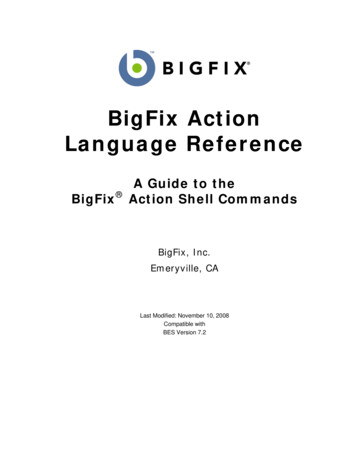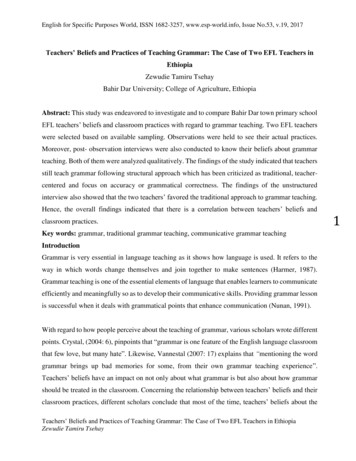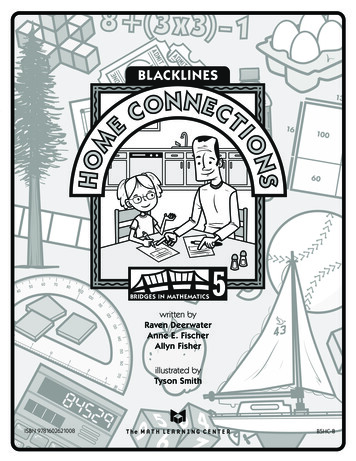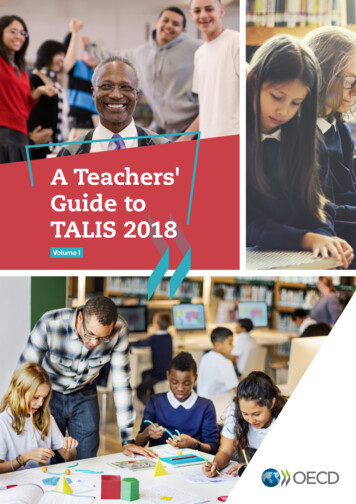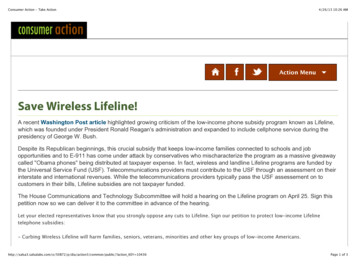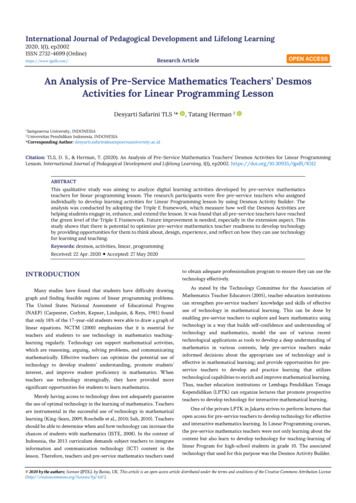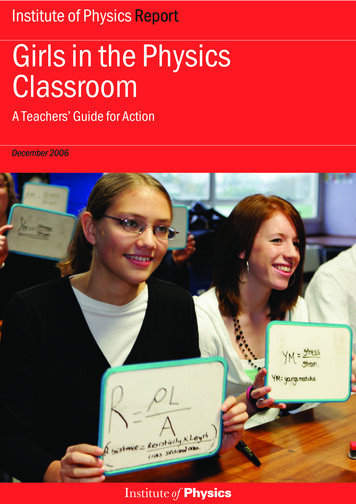
Transcription
Institute of Physics ReportGirls in the PhysicsClassroomA Teachers’ Guide for ActionDecember 2006
AcknowledgementsiiIntroduction11: Lessons from effective classroom practice1.1 The school culture and ethos1.2 The curriculum and its organisation1.3 Classroom organisation and management1.4 Questions and answers1.5 The use of language1.6 The use of analogy and illustration1.7 Relevance445667892: Lessons from research2.1 The student perspective2.2 The curriculum perspective2.3 The teacher perspective2.4 The assessment perspective11111418193: Lessons from videos3.1 Introduction3.2 Getting and using the videos3.3 Summary of programme content232323234: Appendices4.1 Analysis of take-up of physics post-16 by girls in a sample of 1500 schools4.2 Exemplar questionnaires4.3 Checklist: how inclusive is your physics teaching?4.4 Suggested activities to accompany videos2626273031
AcknowledgementsThe authors (Martin Hollins, Patricia Murphy, Bob Ponchaudand Elizabeth Whitelegg) and the Institute of Physics are verygrateful to the members of the working group who gave theirtime to comment and suggest ways forward.The members included:Marie-Noelle Barton, Women into Science and Engineeringand ConstructionDerek Bell, Association for Science EducationDebra Dance, Department for Education and SkillsJoanna Edwards, National Endowment for Science,Technology and the ArtsAndrew Morrison, Particle Physics and Astronomy ResearchCouncilPeter Main, Institute of PhysicsKatherine Mathieson, National Endowment for Science,Technology and the ArtsPatricia Murphy, The Open UniversityJane Nicolson, Engineering and Physical Sciences ResearchCouncilMark Orrow-Whiting, Qualifications and Curriculum AuthorityDaniel Sandford-Smith, Institute of PhysicsElizabeth Whitelegg, The Open UniversityAnnette Williams, UK Resource Centre for Women in Science,Engineering and TechnologyChristine Yates, Imperial CollegeiiINSTITUTEOFPHYSICS REPORT GIRLSIN THEPHYSICS CLASSROOM:ATEACHERS’ GUIDEFORACTION DECEMBER 2006
IntroductionIntroductionYes She Can1 is an investigation by Bob Ponchaud(ex-HMI for science) into schools that are successful atattracting girls to study A-level physics and how thismight inform other schools. Girls in the Physics Classroom: a Review of theResearch on the Participation of Girls in Physics2 byPatricia Murphy and Elizabeth Whitelegg of the OpenUniversity aims to consolidate current understandingof the problem and to identify from existing researchthe reasons why girls choose not to continue studyingphysics. It also identifies the strategies that havesucceeeded in increasing the number of girls studyingphysics post-16.30 00025 000number of candidatesIn 2005 physics was the 12th most-popular A-level in theUK, with 28 119 candidates. Of these, 21 922 were male,making physics the sixth most-popular A-level subject forboys behind maths (32 719), general studies (28 083),English (26 332), history (22 342) and biology (22 046).For girls, physics was the 19th most-common A-levelchoice. Of those who took physics A-level, 34% achievedan A grade. In 2005 only 14% of girls who were awardedan A* or A for GCSE Double Award Science or Physics satA-level physics. In other words there is a very substantialnumber of girls who have the ability to do well at physicsbut who are choosing not to study the subject post-16.The low uptake is not a new problem; figure 1 shows theproportions of girls and boys studying physics between1995 and 2005. For physics teachers this decrease is disheartening. For the UK it is a very serious problem becauseA-level physics is a gateway qualification to a variety ofcareers that make a substantial contribution to the financialand intellectual wealth of the country.In 2004 the Institute of Physics commissioned twopieces of work about girls’ engagement with physics:20 000males15 000females10 000500001995 1996 1997 1998 1999 2000 2001 2002 2003 2004 2005yearFig. 1: Number ofexperience physics to be increasingly difficult. ThisA-level physicsperception is partly due to the mathematical demands candidates.of the subject but also to girls’ developing feeling of “notbeing able to do physics”. The feeling is not borne outby the reality of girls’ performance. The two reports have found that key influences on students’attitudes to physics are:self-concept (i.e. students’ sense of themselves inrelation to the subject : the value they place on thesubject and their willingness to engage in it); views of physics (i.e. how students experience physicsat school); teacher-student relationships (i.e. how personallysupportive students find their physics teacher). This guide draws on the work done by Ponchaud, and byThe reports reveal some of the important issues that under- Murphy and Whitelegg, to identify some of the strategieslie the statistics for examination entries:that schools could use to try to increase the participation ofgirls in post-16 physics: It cannot be assumed that, in the current NationalCurriculum provision, all students, in particular girls, Section 1 is written by Ponchaud. It explores theare gaining meaningful access to physics.lessons that he learned from schools that are Students’ interest in science declines as they progresssuccessfully recruiting girls to AS physics, retainingthrough school and the decline appears to becomethem into A2 and gaining good examination results. Itsteeper after age 14, particularly for girls andalso suggests how this good practice can beparticularly in physics.developed in other schools. Girls, more than boys, experience a difference between Section 2 is written by Murphy and Whitelegg. Ittheir personal goals for learning and the learningsummarises the research findings and suggestsobjectives of the physics curriculum. As apractical ways that you can examine these issues inconsequence they are less inclined to opt for physics,the context of your school, department or classroom.even if they achieve high grades and enjoy the subject. Section 3 is written by Martin Hollins. It is based on two As they go through secondary schooling, studentsvideos: Saving Nellie and Key Stage 3/4 Science: GirlsINSTITUTEOFPHYSICS REPORT GIRLSIN THEPHYSICS CLASSROOM: A TEACHERS’ GUIDEFORACTION DECEMBER 20061. Yes She Can has not previouslybeen published but it forms thebasis for section 1 of this report.2. Murphy P and Whitelegg E2006 Girls in the PhysicsClassroom: a Review of theResearch on the Participation ofGirls in Physics, Institute ofPhysics.1
Introductionin Physics. It suggests how the videos might be used tostimulate discussion among teachers about their ownpractices and encourage school departments to reviewtheir teaching and learning strategies.The intention of this guide is to inform teachers about howgirls experience physics and what influences their motivation for, and learning of, the subject. The practical advice isgrounded in work carried out in classrooms and the methods suggested have been used successfully by other teachers and their students. The aim is to promote informeddebate about this important issue.The work of Ponchaud, Murphy and Whitelegg exploredthe problem from two different perspectives but theyreached a similar conclusion: the issue is not insoluble andteachers have a key role to play. In particular, girls are morelikely to continue with physics after the age of 16 if: 2physics is taught in a way that engages with theINSTITUTEOFinterests of young people;there is an expectation that anyone can do physics; classrooms are managed to ensure activeparticipation by students; the focus of learning is ideas rather than unconnectedfacts; students feel supported in their learning; young people understand the contribution that physicsmakes to society and can make to their lives. Many of the changes suggested in this report simplyrepresent good classroom practice and are likely tosupport both boys and girls in their learning.You don’t have to read this report in its entirety for it tobe useful; you can dip into sections that are of particularinterest in your school context. For example, you may justwant to try those classroom strategies that relate to an issuethat affects your school.PHYSICS REPORT GIRLSIN THEPHYSICS CLASSROOM:ATEACHERS’ GUIDEFORACTION DECEMBER 2006
1: Lessons from effective classroom practice1: Lessons from effective classroompracticeThe author of this section, Bob Ponchaud, was an HMI for13 years and a specialist adviser for science to OFSTED foreight years.The evidence that this section is based on comes fromvisits to schools in England where the take-up of physicsby girls is relatively high. Key Stage 4 (KS4) and post-16lessons were observed to gain an insight into the contextin which decisions about further studies are made and intothe reality of classroom experience thereafter. The resultingevidence is necessarily anecdotal but draws on his longexperience of classroom observation.The research confirms that the best single-sex schools aremuch more successful than mixed schools at getting girlsto study physics post-16. Different levels of resource andtype of intake are a factor. Nevertheless, features of theethos, organisation and pedagogy of these top single-sexschools that lead to their success can be transferred tomixed schools. The adoption of these features is alreadycontributing to improved engagement and take-up in theschools that were visited for Ponchaud’s research.Some schools are much more successful than others atrecruiting girls into physics, as is revealed by informationheld on the OFSTED database.3 Only 80 schools from asample of 1500 recruited 10% or more of their post-16 girlcohort to take physics in 2003. Of these schools, 44 weregirls’ schools and 36 of them selected by attainment. A further 10 out of the 80 had more than 20% of their cohorttaking physics. These 44 schools contributed almost onequarter of the total A-level physics entries for the sample.Research suggests that, once socioeconomic factors andprior attainment have been allowed for, the situation ismuch less stark. However, many lessons can be learnedfrom those schools that are highly successful.The schools that were visited as part of this project had allsucceeded in recruiting girls into AS-level physics, retaining them into A2 and gaining good examination results.4The aim was to identify, by observation and interview, features of the organisation and its teaching of physics thatmight account for this relative success and that could bereplicated elsewhere. Observation and interview protocolswere used but it is not suggested that this project constitutes rigorous research or that causal connections can besupported by anything other than the author’s professionaljudgement.3. Data provided by OFSTEDResearch and Analysis Division(appendix 4.1).4. Some had experienced recentdecline consistent with the overallreduction in AS entries.4girls’ schools had a strong “can-do” culture, which stimulated student self-belief. No teachers or students in theseschools made any mention of the commonly perceived difficulty of physics as a subject. Conversely, in mixed schoolsdifficulty was often cited as a reason why students, particularly girls, did not choose physics. Teachers in the successful schools were not unrealistic about the demands ofsome topics but they viewed these as a challenge to be metby staff and students. Some students regarded this challenge as part of the appeal of physics. One said:“You have to work at it but you get a buzz whenyou feel you understand a new idea. I don’t getthat in other subjects.”It is unlikely that this can-do culture can be establishedquickly or that it is peculiar to physics, but it has a powerfuleffect on student choice.The successful schools had also reduced students’ andteachers’ subjection to gender stereotyping. Discussionswith students showed that many of them were eitherunaware that physics was often regarded as a boys’ subject or discounted this view as out of date or irrelevant. Girlsin one single-sex school commented:“No one has ever told us we can’t do physics orany other subject. People these days canchoose what they want to do.”Some girls indicated that they had not much likedphysics in the early years of secondary education and probably saw it as being more for boys. However, this view hadchanged as a result of a consistently good experience ofthe subject. Another major factor was career aspiration,particularly in the medical or paramedical fields. Physicswas viewed as a highly desirable, if not strictly necessary,subject for entering these professions, which students commonly regarded as fields in which women could excel.One of the strong similarities that emerged between girlsand mixed groups visited during the survey was girls’ preference for a collaborative rather than a competitiveapproach. Even the most able and confident female students would often preface their response to a question withan expression of uncertainty, reflecting not their own doubtbut the recognition that other members of the group might1.1 The school culture and ethoshave an equally valid point of view. Girls-only classes wereWhat is it about some schools that makes them sofar less often dominated by an individual or a minority thansuccessful at recruiting girls into physics and is thisin the case of mixed groups. Group activities, such as disquality transferable?cussion or presentations, were also well liked by them.The schools visited during the survey had a number of comThe number of students taking A-level physics in mixedmon features that were reflected in the classroom and in schools often fluctuates more than the take-up in girls’students’ responses during interview. The most successful schools. Teachers, particularly those in mixed schools,INSTITUTEOFPHYSICS REPORT GIRLSIN THEPHYSICS CLASSROOM: A TEACHERS’ GUIDEFORACTION DECEMBER 2006
1: Lessons from effective classroom practicereported that it was common for female friendship groupsto opt for physics. Many of the girls interviewed said thatthey had discussed subject choice in some detail withfriends, whereas boys mostly decided independently. Thisdifference was perceived by teachers as reflecting the girls’reluctance to be isolated in a boy-dominated class.However, girls indicated that they simply arrived at a consensus about subject options and would, if necessary, bewilling to join a largely male group.In a girls’ selective school for 11–18-year-olds, with800 pupils on role, there are 60 pupils studying physicsat AS-level and 50 at A-level. Teachers have establisheda can-do culture and teaching takes account of the needsand interests of girls, giving them the confidence tocontinue the subject. Teaching is enthusiastic but verywell planned and organised.The culture and ethos in the successful girls’ schools cannot easily be replicated elsewhere. In any case the culturecannot be attributed to a single subject department.Nevertheless, there may be some useful messages to begleaned about how physics should be represented andorganised in all schools.Messages for practice Accentuate the positive wherever possible and avoidportraying physics as an essentially hard subject. Girlsin a mixed school are more likely to be deterred thanboys. Take positive steps to reduce the impact ofstereotyping. All staff, not just physics teachers, needto be well informed about the issues. In particular,teachers must avoid reinforcing stereotypes,endeavouring not to use mostly male examples whentalking about occupations or interests. Make sure that physics is viewed as a valuable subjectin its own right, not just regarded as a qualification forcareers in science and engineering. Encourage collaborative approaches to the teachingand learning of physics and avoid domination byindividuals (see also section 1.3). Invite staff to be proactive in discussing study options.They should not just give information; they should give aninsight into what studying physics will be like. InvolveA-level students and encourage them to give an honestappraisal of their experience.1. 2 The curriculum and its organisationScience and Applied Science, will encourage a fresh look atthe nature and organisation of the curriculum, so it is timelyto reflect on possible gender issues.Double Award “Balanced” Science was originally introduced to ensure that all pupils experienced each of themainstream science disciplines up to the age of 16. It washoped that this would increase the proportion of girls takingphysical sciences beyond this age. There is little evidenceto suggest that it has been successful in this respect,although all pupils now receive a grounding in physics. Likemost schools, those visited as part of this survey offeredDouble Award Science. Most of them also taught separateTriple Award GCSEs in biology, chemistry and physics.The science curriculum has become increasinglyfragmented. The Key Stage 3 (KS3) scheme of work provided by the Qualifications and Curriculum Authority (QCA)divides the science curriculum into 37 units and most KS4specifications are similarly divided into short modules.Many of the girls spoken to during the survey complainedthat they could not see where “everything fits together”;they perceived science as a series of unrelated facts andwanted to see the big picture. As one girl not intending tocontinue with physics said:“I can understand the individual bits but I don’tsee how they fit together so don’t reallyunderstand why we are studying it or what use itis to me.”This was viewed as less of a problem in biology, for whichthe students considered the unifying themes to be clear.At GCSE, physics was seen as the most disparate subject.The schools that were most effective at recruiting girls alltaught physics as a separately timetabled and staffed subject, even where it was part of a Double Award Scienceprogramme. Continuity of staffing appeared to be a majorfactor influencing girls’ study choices. They were keen toknow who would teach them if they chose to continue thesubject. Staffing can be more of a problem for some typesof schools in some areas. However, it is worth noting thatgirls’ preferences were not strongly associated with the individual personalities of teachers but with a teaching stylethat was understandable and regarded as effective.“I don’t particularly mind who will teach me nextyear [year 12] but I do want to know – it’s partof the package really.”What can schools do to make the science curriculummore gender inclusive?Since the National Curriculum was introduced in 1989, thecontent of GCSE science courses has been closely prescribed. Nevertheless, schools still have the freedom toorganise the curriculum in ways that best meet the needs oftheir pupils within the constraints imposed by staffing. Thedevelopment of new GCSE courses, such as 21st CenturyIn the schools that were visited there was little to suggestthat teacher role models were a major influence on attitudes to the subject of physics or post-16 decisions aboutstudying it. Some teachers in mixed schools attributed adecline in the take-up of physics post-16 to the loss of aparticular teacher but pupils seldom cited this as a reason.The effectiveness of teaching and the ability “to make itinteresting” were regarded as much more important thanthe personality or gender of a teacher.INSTITUTEFOROFPHYSICS REPORT GIRLSIN THEPHYSICS CLASSROOM: A TEACHERS’ GUIDEACTION DECEMBER 20065
1: Lessons from effective classroom practiceIn a mixed comprehensive school for 11–18-year-oldshas moved away from modular Double Award Science toimprove continuity. It now has specialist teaching for thebiology, chemistry and physics components of a DoubleAward course. Teachers commented: “We felt that wewere making pupils jump through hoops at regularintervals rather than developing key ideas in thedisciplines over time.” School-developed resources andlinks to websites are available for each topic on theschool website and pupils are encouraged to reviewcertain areas before starting a new unit. So far pupilshave done just as well at GCSE as previously and take-upof sciences in general and physics in particular hasimproved. More girls are taking physics.Messages for practice Avoid fragmenting the pre-16 science curriculum morethan absolutely necessary; plan to make explicit linksbetween related areas. The use of “mind/conceptmaps” or group preparation of displays summarising atopic may be a useful approach. Give weight to continuity of specialist teaching whentimetabling. If possible, enable pupils to experiencethe teaching style that is likely to be used post-16.particularly when they were working in single-sex groups.In these situations, girls often displayed superior organisational skills to boys and divided up tasks in a systematicway. Tangible outcomes, such as display materials, wereof high quality in content as well as presentation, and theseoften helped girls to articulate their understanding.Several teachers distinguished between social and working groups. Pupils were usually allowed to sit with other students of their own choosing but they were expected to workin different combinations depending on the activity. Onceestablished, this approach was not questioned by pupilsand it ensured that each of them adopted a variety of rolesover time. Girls, in particular, were pleased to be freed fromthe role of recording and note-taking. Varying the groupingsin which students worked also enabled the teachers toemphasise the co-operative nature of physics, debunkingthe view that physics is always a solitary activity.Pupils are grouped differently depending on theactivity. Discussion groups are single gender but followedby whole-class plenary. Practical groups change andindividuals are nominated to report back findings. In thisway there are no passengers –all pupils play an activepart yet none can dominate. Girls hold their own and arenot overshadowed by a small number of vocal boys.1.3 Classroom organisation andmanagement5. In a Class of Their Own?Teaching science in single-sexclasses in co-educational schools– a guide to good practice (2004)WISE.6Messages for practiceHow can teachers vary their classroom organisation to Distinguish between social (seating) groups andencourage full participation by girls in physics?working groups and change the latter periodically.The recently published guide In a class of their own5 Try out different groupings for most practical work anddescribes how some coeducational schools have createddiscussion, perhaps including single-sex groups assingle-gender groups for the teaching of science. None ofpart of an overall strategy for improving thethe mixed schools visited as part of this survey had formedparticipation of girls.such groups but many of them employed a variety of group- Ensure that all girls play an active part in activities anding strategies for different classroom activities.do not just act as note-takers.Some schools often organised pupils into single-gender Group students according to their learning needs andgroups for practical work. Teachers found that, in mixedaptitudes not for classroom control.groups, boys tended to rush into practical activity while girlsoften wanted to draw up tables for results or carry out other 1.4 Questions and answerspreparatory work before starting an experiment. This led to How can teachers frame and address questions ina polarisation of roles, with boys becoming the “doers” and ways that will encourage girls to respond and togirls becoming the “scribes”. A typical comment was:articulate their understanding and concerns?The questioning technique that teachers use is a crucial“We like to think things through and know whatfactor in engaging girls in physics. In a mixed class, boyswe’ve got to do. Boys just jump in and don’twill almost always be the first to respond to a request forseem to worry if they get it wrong.”“hands up” to answer a question directed at the wholeclass. Very few of the teachers who participated in this proSingle-sex practical groups in schools that projected a ject used this approach because they were well aware thatcan-do approach helped to improve involvement by girls in girls would be less likely to contribute. By allowing thinking“hands-on” practical activities. However, even in the sin- time, most of the teachers also avoided instant responses,gle-sex groups, students rapidly adopted narrow roles. One which typically came from boys and denied other studentsschool overcame this problem by assigning tasks to differ- the opportunity to reach an answer.ent students in a group on rotation.Some of the most successful lessons observed included“A hand up means that someone wants to ask asmall-group activities, such as the discussion of an issuequestion. I use other ways – such asor the preparation of a presentation or some display materwhiteboards – to find out who can rememberials. These approaches were generally popular with girls,something. I ask fewer questions and allowINSTITUTEOFPHYSICS REPORT GIRLSIN THEPHYSICS CLASSROOM: A TEACHERS’ GUIDEFORACTION DECEMBER 2006
1: Lessons from effective classroom practicemore time for thinking. This stops boys jumpingin and encourages girls to contribute.”A large proportion of questions in physics are closed (i.e.they require brief factual responses). Many of them areused to check whether the class has taken specific information on board, such as instructions for practical work orthe definition of a physical quantity. Such questions dohave a part to play but they do little to engage students orto elicit real depth of understanding. Many of the girls spoken to for this project regarded them as pointless:“Why ask us things when they are on the sheetor in the book anyway? It’s just a question ofwho can find it or remember it first; it doesn’tmean you understand it. I don’t bother to put upmy hand any more.”The girls perceived questions in biology as more likely tobe linked to a mechanism or life process and in chemistryto be linked to an observation. Despite this, even the mostable and otherwise confident girls responded in an apparently diffident way to more extended questions in physics.Answers were often prefaced by expressions of uncertainty:“I’m not really sure about this but I think ” and“This probably isn’t right but.”boards to communicate their concerns as well as answers.Group responseTables or small groups of pupils were asked to discuss aquestion briefly or to apply a principle and come up with ajoint response. This lowered the stakes for individuals andencouraged the more diffident pupils to contribute orrespond on behalf of others.Articulation gamesMany learning games are now available in published formor on the Internet. Some of them, called articulation games,require pupils to explain terms, processes or principles toothers who must then guess what is being described. Thesegames appeared to be particularly successful in mixedgroups, with boys often having to be more thoughtful andgirls more confident in their articulation.Good questioning techniques are effective for all pupils,but the current shift away from rapid-fire closed questionstowards those that require a more open and extendedresponse is likely to benefit girls in particular. The researchfindings and guidance given in King’s College London“Black Box” publications6 are universally applicable butmay be very relevant in the context of girls and physics.Individual whiteboards are available and frequentlyused during lessons. Sometimes they are used to providethe teacher with an overview of pupils’ recall ofinformation or for quick calculations. On other occasionspupils are asked to respond to more open questions,such as “What do you think will happen if ” All pupilsseem to enjoy using the boards but girls do particularly. “Ialways have a go because I know if I get it wrong nobodyelse knows and I can wipe the board clean anyway.”Sometimes the teacher asks groups to discuss theirresponse and nominates individuals to explain the groupanswer.Discussion revealed that they believed that physics wasalways precise and unambiguous and that they felt unableto give the “right answer” in its totality. They also wanted toleave the way open for other students who might have abetter or fuller response. Teachers sometimes interpretedfemale students’ tentative replies as showing a lack of deepunderstanding, yet often the reverse was true.The teachers who were most successful in engaging andinspiring girls used a variety of questioning techniques tocounter all of these concerns. Avoidance of the hands-upapproach and allowance of more time to respond wereused by almost all of them. Closed questions were used Messages for practicesparingly and it was assumed that worksheet and textbook Decrease the use of hands-up, closed, rapid-responsequestions.instructions would be read and followed. Emphasis on theuse of questions to regulate and control was replaced with Encourage the view that there is not always a uniquecorrect answer.questions designed to engage and stimulate thought.Several specific techniques were also used to encour- Give pupils the privacy and confidence to take riskswhen answering questions.age greater participation by girls in question-and-answer Try whiteboards for quick, individual responses.sessions and to utilise their strengths. Invite group discussion with a spokesperson as a wayof lowering the stakes and encouraging collaborativeIndividual whiteboardslearning.“Show me” boards were used at all levels to encourage allpupils to think about a topic and to produce a brief writtenresponse to a question. The written response was then dis- 1.5 The use of languageplayed just to the teacher. This activity enabled teachers Is there an unwitting gender bias in the use ofto gain an overview of the class as well as an understanding language in physics and, if so, how can this beof individuals. Pupils were able to respond without the worry diminished
For girls, physics was the 19th most-common A-level choice. Of those who took physics A-level, 34% achieved an A grade. In 2005 only 14% of girls who were awarded an A* or A for GCSE Double Award Science or Physics sat A-level physics. In other words there is a very substantial number of girls wh




